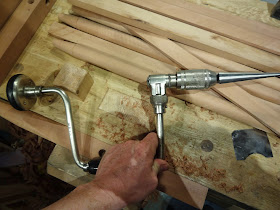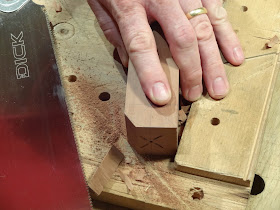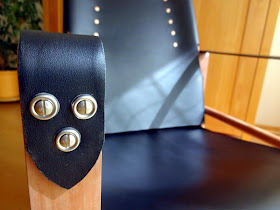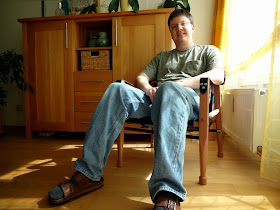It has been another of those times where I haven't been able to get enough shop time. That, and the project I am working on is getting more and more frustrating.
What to do? Same as I always do. Start another project!
Last summer Christopher Schwarz taught a couple classes at Dictum here in Germany. The first was making a bowsaw. That class I attended and was pleased with. The other class was building a Roorkee chair. I was not pleased with this class as I couldn't go. I had to work. I did, however, crash a couple of mornings and imposed myself on the group at the Biergarten at the end of a couple days. That chair looked so fun to build, I knew I just had to do it myself one of these days.
Lost Art Press released Chris' new book a week or two ago, 'Campaign Furniture.' I bought a copy and also downloaded the ebook. It seems to be a great book so far. I have to admit, that I haven't read it all. I skipped to the chapter about Roorkee chairs and got really excited. I decided I had to build one.
Looking at my available stock, I had plenty of pear that was thick enough for the legs of the project. This pear was earmarked for another project, but I decided that the other project isn't going anywhere and I want to build a Roorkee, so pear it is. After all, wood grows on trees. I can always get some more, right?
The first night of the build I broke down my roughstock and cut out leg blanks by hand. Not so fun in 2" thick lumber, but good practice. Once I got them cut out, for good measure I planed reference faces and reference edges. This whole process took about three hours.
 |
| Several hours of work getting these bits cut out of a solid chunk of wood. |
I like hand tools, but I'm not a sadist. The next day, I thought I'd run down the road to the Dictum store and see if I could get into their shtop.
 |
| Good news: the shop is open! |
I spent the next 20 minutes running the pear through the machines until I had all of the parts needed for the Roorkee cut out, jointed and planed, and ready to go.
 |
| If you have the opportunity to use a machine like this, do it! |
While I was there, I decided to turn the parts as there is a lathe, also. I have no lathe in my 100 square foot shop. No machines, at all.
I did something a bit outside of my usual philosophy: I bought an Easy Rougher. If you were to read my earlier blog posts about what tools you should buy, you might be correct in thinking I would recommend a traditional tool, learning how to sharpen and use it as the skill is something that you'll use forever. However, I did decide to buy this tool, which has a carbide insert for a blade and works by scraping. It is very easy to use, and easy to learn. I justified buying this tool as I just wanted to get the parts turned for this project and get it over with. I am not really interested in learning to turn much, I just wanted to get the legs for this chair done.
Sue me.
 |
| My first real turning project. |
I think I need some practice, as I had an awful lot of sanding and scraping to get the tool marks out of the wood, but overall I was pleased with the result. Every once in a while, donkey work just needs to get out of the way for the fun part. In three hours, I had processed all of the stock to get parts for my Roorkee, learned to turn and turned all of the legs as well as all four stretchers of this project.
 |
| The results of half-a-day's work in a power tool shop. |
Next up in the project is laying out the holes for the stretchers and boring them. I made myself a story stick to assist with the turning layout, and decided to use it again here to lay out the holes. I drilled three 1/8" holes (big enough to hold a pencil) and used the story stick to mark the points on the legs where the stretchers should go.
 |
| "Finger Weg!" is the only German phrase you need to know to get by in Germay other than, "Stimmt." |
 |
| Only three different measurements for boring stretcher mortices. |
 |
| In action. Notice the leg and the story stick are butted (is that a word?) up against my planing stop. |
Once the layout is complete, bore away! I used a 5/8" bit in my brace. I would recommend practicing a bit first to get good at boring straight holes. Once you got it, you got it. I use a single 6" square as an aid when I need them to be dead-nuts perfect. I am looking at the square from two sides to ensure the bit is straight.
 |
| boring... |
 |
| I usually keep my eyes in front of the bit, which keeps the hole going in straight from that way. Every once in a while, I peek over to see this, the square and the bit lined up. At least, hopefully I do. |
Now a quick word on buying more tools. You really need both Jennings bits as well as Irwins. Many people would look at the below photo and say the left bit is for hard wood and the right bit for soft, as the left obviously has finer lead-screw threads than the right.
Those people would be wrong.
 |
| Jennings on the left, Irwin on the right. |
Jennings bit has threads in the lead screw are doubled up, where as the right they are a single screw. Normally I prefer a Jennings bit, but in pear the lead screw kept clogging up. After 1/2" to 3/4" of boring, the lead screw would get clogged and the bit would quit cutting. Once I changed to the Irwin bit, there was no more clogging. The Irwin bit would consistently drill the entire way with no clogging. If you are having trouble with your bit clogging, try using the other kind of bit. It made my boring go four times faster.
The next step is to ream out the 5/8" holes you just bored into tapered mortices. I again used my brace, and was very careful to ensure everything stayed nice and square.
 |
| For some reason, this looks weird to me. |
When I get a few turns in, I insert a stretcher and measure. If I need to make some adjustments, I do, and then I check again when I am almost to the bottom. Once you are at the bottom, there isn't much room to make corrections.
 |
| Checking the stretcher. |
Once this was done, I checked to see if it all fit.
 |
| I think I need to adjust some tenons and mortices, but overall I'm happy. |
Now we get to the fun part. How to shape the rounded tops of the legs. Chris Schwarz recommends in his book to mark it out using a template and using a band saw. Due to a slight miscalculation, my legs turned out a bit skinnier than he recommends. To get the top to look round, I used my combination square to mark 45 degree lines from the corners and rounding from that center point with a compass.
 |
| The layout for the curved top. Also, you can see the tools I will use to do it, besides a hand saw. |
I'll get a bit specific with this. This technique will be handy for the folks at William Ng's this week. If you find yourself 12th in line to use the band saw, try this and get on with it. The whole process took me less than ten minutes each to go to a finished surface.
 |
| I first sawed off the corner at about 45 degrees. |
 |
| A closer look. |
 |
| I can't pass up an opportunity to point out my DICK saw! |
 |
| Just pare away the sharp corners with a chisel. Take light cuts and go down to the line. |
 |
| Notice the grip: No flesh is in front of the blade. If I slip, the tip just goes into my backer board, not a vital artery. |
 |
| A little more progress... |
 |
| I think this is smoother than I could do with a bandsaw. Now for the rasp: |
 |
| Some light rolling cuts with the rasp down to the line and Voila! |
 |
| I could have done this in about a half an hour if I didn't continually stop to take pictures. |
Now to drill a hole on the back legs to hold the back pieces. More precision boring, I go in a few turns on one side, flip it over and drill all the way through from the back. This prevents blowout, and also helps match up the hole in the middle. It does need to be perfect for a bolt to fit in.
 |
| Same drill, different bit... |
 |
| First from one side, then the other. Notice the nice long shavings one gets with a sharp bit. |
 |
| Not too shabby. But the real test... |
 |
| Does a bolt fit? Yes! |
Pretty much now all I have to do is finish. I decided to go with one of my stand-byes: polissoir the crap out of it, then finish with straight beeswax with more polissoiring.
 |
| This is as far as I got tonight. I'll finish the waxing in the morning. |
If you're still reading this enormously long post, congratulations! You are one of my hard-core fans!
Next time - Leather!

































